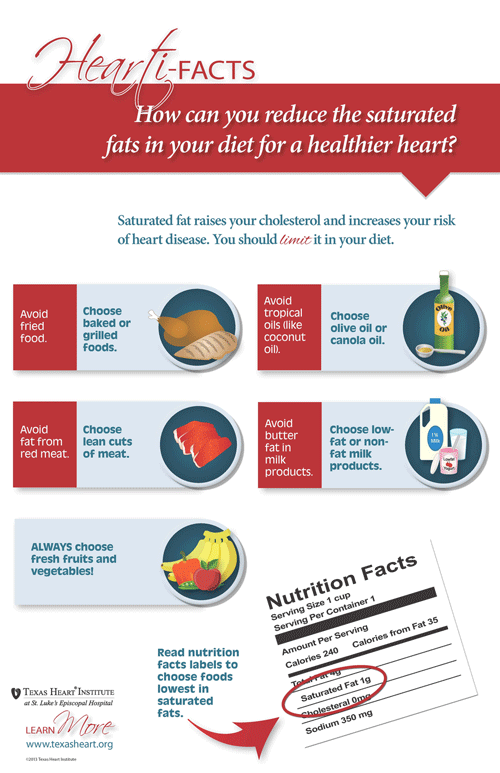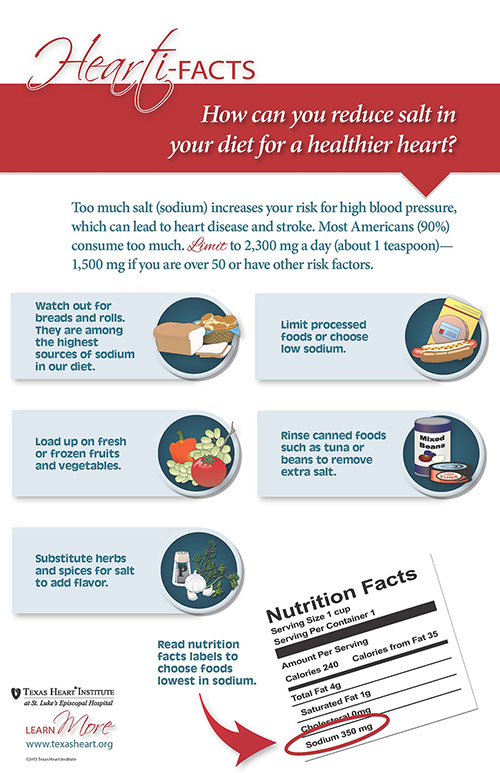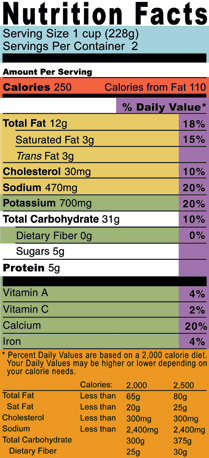Eating a nutritious, well-balanced diet offers one of the simplest, most effective ways of reducing your risk of heart disease, cancer, and other health problems. Good nutrition means eating a variety of foods, moderating your intake of certain foods and drinks, and controlling the amount of food and calories you eat. A balanced diet can help you reduce your risk of heart disease by lowering your cholesterol and blood pressure, as well as by helping you to lose weight.
Food and Nutrients
Your body needs nutrients to work properly. The nutrients you need include carbohydrates, proteins, fats, vitamins, and minerals. Your body gets these nutrients from the foods you eat.
|
US News & World Report Publishes Annual Best Diets Report
U.S. News evaluates and ranks more than 30 diets. To be top-rated, a diet has to be relatively easy to follow, nutritious, safe, and effective for weight loss and against diabetes and heart disease. The government-endorsed Dietary Approaches to Stop Hypertension (DASH) snagged the top spot. Ranked #2, Therapeutic Lifestyle Changes, or TLC, is a very solid diet plan created by the National Institutes of Health. It has no major weaknesses, and it's particularly good at promoting cardiovascular health. Read the full report.
|
The news is always filled with stories about diet and nutrition, making it hard to know what to eat and what not to eat. If you think that you are not eating a well-balanced diet, if you have health or weight problems, or if you are about to make major changes to your diet, talk to your doctor or a dietitian who can help you decide on a nutrition plan that works for you.
The US Department of Agriculture (USDA) and the Department of Health and Human Services provide guidelines to help us. Called the Dietary Guidelines for Americans, they focus on balancing calories with physical activity, and encourage you to eat more vegetables, fruits, whole grains, fat-free and low-fat dairy products, and seafood. They also urge you to eat less sodium, saturated and trans fats, added sugars, and refined grains. To learn more, see the Choose My Plate section at the end of this topic.
Recent studies have proven the benefits of the Mediterranean Diet in promoting cardiovascular health. To learn more, see The Mediterranean Diet section at the end of this topic.
Carbohydrates
Carbohydrates are the main source of fuel in a balanced diet. The body converts carbohydrates to "glucose," which is a type of sugar. Your body uses some of this glucose right away for energy, and any extra glucose is converted into a sugar called "glycogen." Your body stores glycogen in your liver and muscles for future use. Glycogen can be quickly changed back to glucose as needed. Once your body has made enough glycogen, the leftover glucose is stored as fat.
Sugars and starches are carbohydrates. Sugars are called "simple carbohydrates" or "simple sugars." The most common form of simple sugar is glucose. When glucose molecules link together, they create a number of larger molecules called "complex carbohydrates." Starches and fiber are examples of complex carbohydrates.
Most carbohydrates are in the form of starches, which are found in foods such as grains, potatoes, and other starchy vegetables. Another common source of starch in our diets is refined grains, like white bread and pasta. Starches also may be added to foods to thicken or stabilize them. Added sugars and added starches usually increase the calorie count of foods, but they do not add essential nutrients. Although most people consume an adequate amount of total carbohydrates, many people consume too much added sugar and refined grain and not enough fiber.
Sugars
Sugars, or simple carbohydrates, give the body a quick source of energy, because they can be used right away. Refined and brown sugars, syrups, and honey are examples of sugars. Added sugars are those found in foods like candy and soft drinks, but they add more calories than nutrients to your diet. According to the Dietary Guidelines for Americans, you should reduce the number of calories you get from added sugars. Instead, you should try to get your daily supply of sugars from fresh fruits, which will also add vitamins and minerals to your diet.
Starches
Starches are called complex carbohydrates because your body must break them down to use their sugars. Breads, cereals, corn, peas, potatoes, pasta, and rice are examples of complex carbohydrates. Many studies have shown that people who eat a lot of whole grains have a lower risk of coronary artery disease than people who mainly eat high-fat or high-sugar foods.
Fiber
Fiber is another form of complex carbohydrate. A diet high in fiber has been shown to reduce cholesterol levels and help protect against heart disease, cancer, and stomach and bowel problems. Fiber comes in two forms: insoluble and soluble. Insoluble fiber can be found in cereals, whole-grain breads, rice, and many vegetables. Soluble fiber is found in oatmeal, dried beans, peas, and many fruits, including apples, strawberries, and citrus fruits.
The latest dietary guidelines recommend eating 14 grams of fiber per 1,000 calories, or 25 grams per day for women and 38 grams per day for men. You should try to eat foods that contain both insoluble and soluble fiber. Both forms are important to your diet. A diet high in soluble fiber may lower your risk of heart disease by decreasing your blood cholesterol. Insoluble fiber helps speed the passage of food through your digestive tract, keeping your body "regular." Eating fiber-rich foods may also help you lose or control your weight because most high-fiber foods provide complex carbohydrates, protein, vitamins, and minerals with little, if any, fat. Also, fiber takes up more space in your stomach and digestive tract than fats and simple sugars do, so you may feel full without eating as many calories.
Proteins
Proteins give your body the building materials for the growth, maintenance, and repair of tissues and muscles. Proteins also help your body make hormones. Extra protein is converted and stored in your body as fat, which can be used as emergency fuel when carbohydrates and fats are not on hand.
There are two main types of protein: animal protein and vegetable protein. Foods rich in animal protein include beef, pork, fish, chicken, eggs, and dairy products. Some foods that contain vegetable protein are broccoli, lentils, potatoes, pasta, oatmeal, rice, nuts, chickpeas (garbanzo beans), soybeans, and kidney, lima, and navy beans.
Although animal products are a good source of protein, eating a lot of animal products can raise your cholesterol level since animal products are often high in cholesterol and saturated fat.
Dietary guidelines suggest that we should eat more protein in the form of seafood. Seafood contributes a range of nutrients, notably the omega-3 fatty acids, eicosapentaenoic acid (EPA) and docosahexaenoic acid (DHA). Studies have shown that eating about 8 ounces of seafood per week is associated with reduced number of heart-related deaths among people with and without heart disease.
Fats
Dietary fat is an important part of your daily nutrition, but you only need a small amount to keep your body's chemistry in balance.
Dietary fat comes in 2 basic forms: saturated and unsaturated.
Saturated fat is the type of fat that raises your cholesterol and increases your risk of heart disease. Main sources of saturated fat are the butter fat in milk products, fat from red meat, and tropical oils such as coconut oil.
Unsaturated fat is better for you. It comes in 2 forms: monounsaturated or polyunsaturated. Vegetable oils are the best-known sources of unsaturated fat. Keep in mind, though, that a "100% vegetable oil" product may not live up to its name. Hydrogenation, the process that turns liquid vegetable oil into hydrogenated or partially hydrogenated vegetable oil to make shortening, margarine, and other solids, turns unsaturated fatty acids into saturated fatty acids. In general, you can easily recognize saturated fats because they will be solid at room temperature. Think of butter, stick margarine, shortening, and coconut oil. On the other hand, olive oil, canola oil, peanut oil, and liquid margarine are liquid at room temperature because they contain mainly unsaturated fat.
Another good way to tell whether a fat is saturated or unsaturated is to look at the label. Food manufacturers are required to list saturated fat separately, so this type of unhealthy fat is easy to spot.
In addition to saturated fat, the hydrogenation process creates another kind of unhealthy fat: trans fatty acids. This type of fat is also listed on food labels. Trans fatty acids are made when unsaturated vegetable oils are hydrogenated. The unsaturated fatty acids that do not become fully saturated may instead become trans fatty acids, which also may contribute to heart disease. Trans fatty acids have been shown to lower levels of "good cholesterol" and raise levels of "bad cholesterol."
In general, you can lower your trans fatty acid intake by avoiding foods that contain ingredients such as margarine, shortening, and hydrogenated or partially hydrogenated oils. Also, you can avoid foods such as french fries, doughnuts, cookies, and crackers, which are often high in trans fatty acids as well as saturated fat. Since trans fatty acids rarely occur naturally, they are mostly found in processed foods made with hydrogenated vegetable oil.
Food labels, cookbooks, and nutrition books provide helpful information about the fat content, calorie content, and the percentage of calories from fat. You should limit your total dietary fat intake to 20-35% of your daily calories. (The typical American diet derives about 40% of its calories from fat.)
Understanding Food Labels
Reducing the amount of fat you eat will help you lose weight. Each gram of fat has 9 calories, compared with 4 calories for each gram of carbohydrate or gram of protein. So, replacing fat with protein and complex carbohydrates means eating fewer calories. Keep in mind, though, that many good protein sources like peanut butter, milk, and cheese may also be high in fat. Also, be careful of sweets and snack foods that are labeled "low fat" or "fat free." These foods often contain large amounts of sugar or added salt and are high in calories. Complex carbohydrates such as fruits, vegetables, and grain products are lower in calories than the refined carbohydrates often found in sweets and snack foods.
Ways to Reduce Saturated Fat in Your Diet
Vitamins
Vitamins are substances that perform specific functions for your body's reproduction and growth. Vitamins regulate your body's metabolism, which controls the amount of energy you have to do things like walking, sleeping, or thinking.
Doctors have also found that certain vitamins might help prevent coronary artery disease. Vitamins A, C, and E appear to deter plaque from forming on artery walls. Plaque forms because oxygen and LDL ("bad") cholesterol combine in a process called "oxidation." Vitamins A, C, and E are called "antioxidants" because they slow or stop the plaque-forming process.
Vitamins: What They Do and Where to Get Them
Minerals and Trace Elements
Minerals are chemical elements that your body uses for many biological processes. Like vitamins, minerals are found in the foods we eat. Trace elements are also chemical elements, but your body only needs small amounts of these substances.
Minerals: What They Do and Where to Get Them
Trace Elements: What They Do and Where to Get Them
Salt (Sodium)
 Salt is a mineral. Although your body needs minerals to work properly, salt can raise blood pressure in people who are sensitive to its effects.
Salt is a mineral. Although your body needs minerals to work properly, salt can raise blood pressure in people who are sensitive to its effects.
Even if you are not sensitive to salt's effects, you will not benefit from eating a lot of salty foods. Snack foods, luncheon meats, and various forms of fast and processed foods are main sources of salt. Also, many recipes for home-cooked meals may have more salt than is needed for good flavor.
In general, try to limit your sodium intake to less than 2300 mg a day, roughly the amount in a teaspoon of salt. The dietary guidelines recommend a limit of 1500 mg a day for adults over 51 years of age and for high-risk populations. Ask your doctor or dietitian about your sodium limit.
Most Americans Should Consume Less Sodium
The Centers for Disease Control and Prevention (CDC) has a comprehensive resource guide to help adults and children reduce sodium in our diets. "the vast majority of sodium we consume is in processed and restaurant foods. Although it is wise to limit your use of added table salt while cooking and at the table, only a small amount of the sodium we consume each day comes from the salt shaker.
http://www.cdc.gov/salt/index.htm
|
Ways to Reduce Salt in Your Diet
Understanding Nutrition Facts Food Labels
 When was the last time you looked at a food label and completely understood what it said? Although the "Nutrition Facts" labels are on every packaged food item, few of us have had lessons on how to actually read these correctly.
When was the last time you looked at a food label and completely understood what it said? Although the "Nutrition Facts" labels are on every packaged food item, few of us have had lessons on how to actually read these correctly.
Learn to read labels to guide your choice of heart-healthy foods. They provide valuable information about calories, fats, cholesterol, sodium, carbohydrates, fiber, sugars, proteins, and vitamins and minerals. Pay close attention to servings per container and to the % of daily value of each nutrient.
In the news ...
Use food labels to prevent heart disease, physicians say
Food labels can be your biggest friend or your worst enemy. While food labels contain useful information that can help you take charge of your health, they can also be confusing and even misleading if you don't know how to properly interpret the information they provide. To view tips and become food-label "savvy," read more in Web MD.
|
Understanding Food Labels
Body Fat
Taking control of your diet is one of the best ways you can lose weight and a healthy diet can give you more energy.
Obesity has been found to be a major risk factor for heart disease and researchers are now better able to define that risk. Many doctors measure obesity in terms of body mass index (BMI), which is a formula of weight in kilograms divided by height in meters squared (BMI =W [kg]/H [m2]). You can find out your BMI by using the calculator below. Then, take that value and find your body composition in the table below the calculator.



